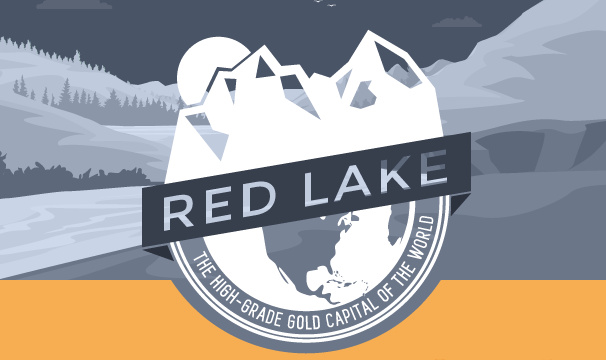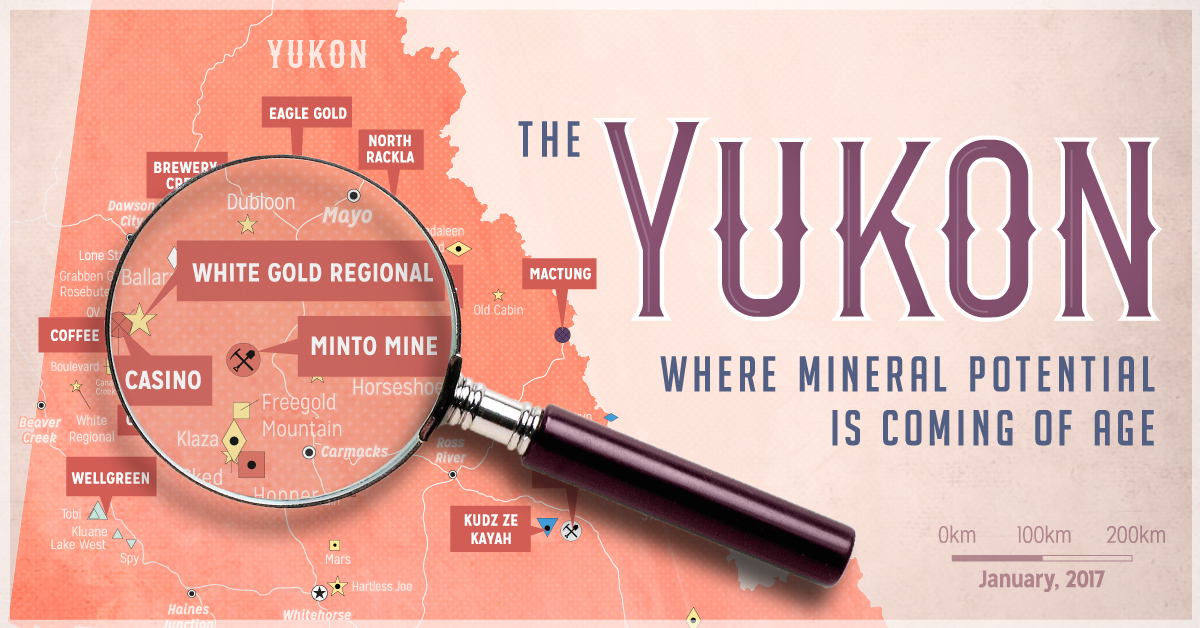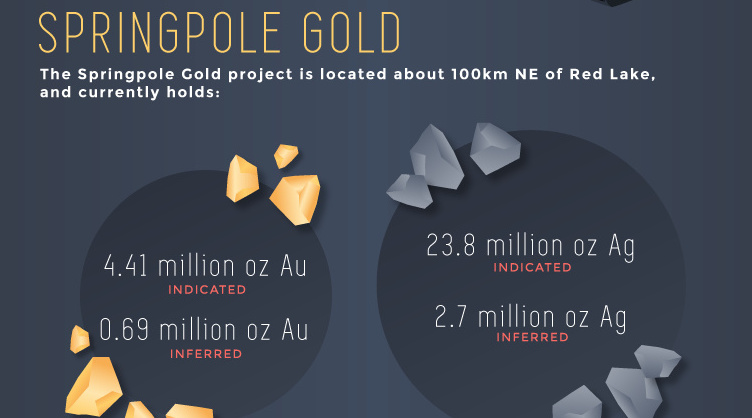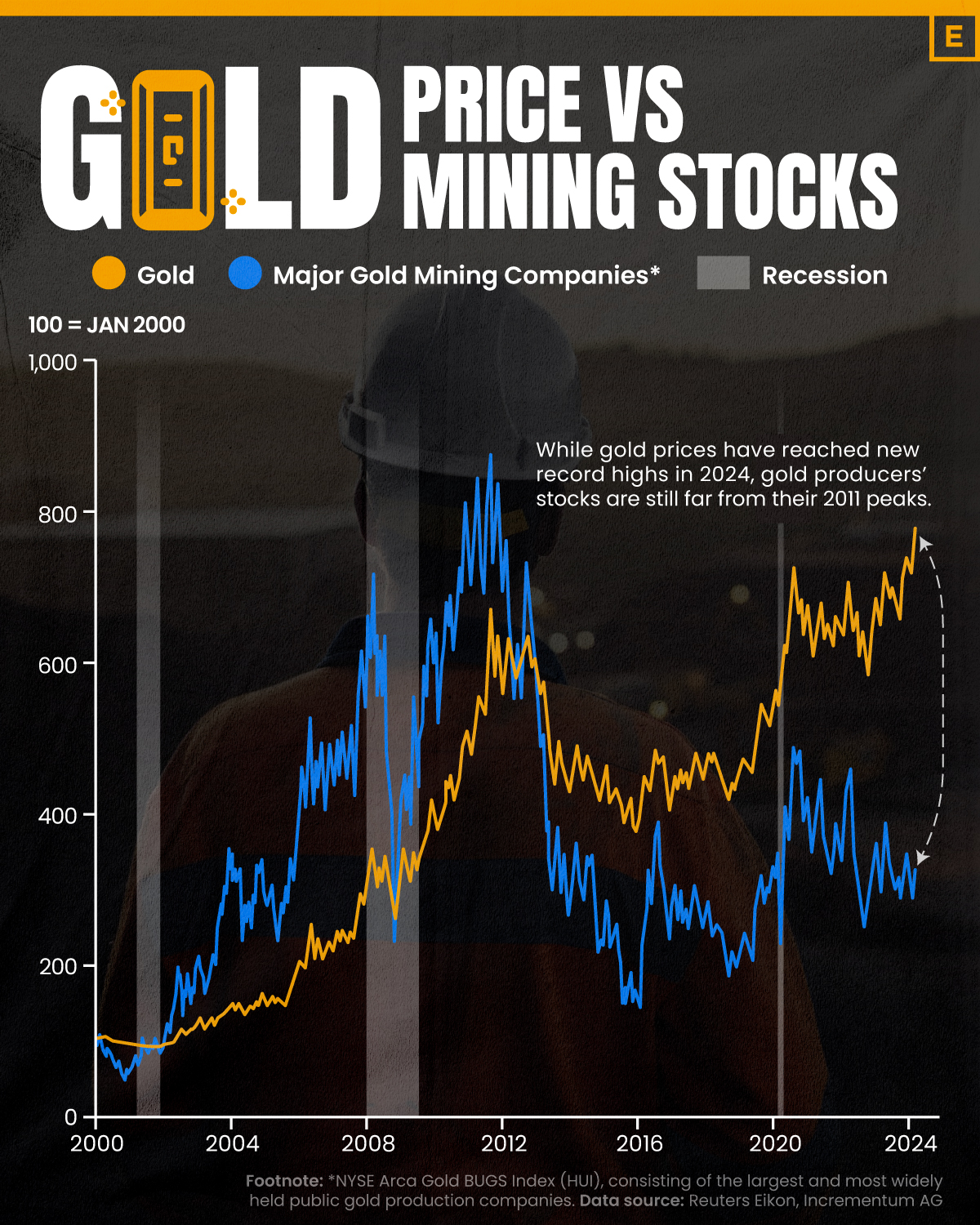Mining
Red Lake: The High-Grade Gold Capital of the World

Red Lake: The High-Grade Gold Capital of the World
Sponsored by Gold Canyon Resources (TSX-V: GCU)
Every major gold producing country has an iconic gold producing trend that is synonymous with prosperity. South Africa has the Witwatersrand Basin and the United States has the Carlin Trend in Nevada.
While Canada has had many prolific gold producing regions over the years, including many famous gold rushes, lately the gold capital of Canada rests in Red Lake, Ontario. It is here – in some of the world’s richest gold deposits – that the yellow metal is famously produced at the astonishing rate of two troy ounces per tonne.
The Geology
Like much gold in Ontario and Quebec, deposits are found in a greenstone formation at Red Lake.
Most of the gold production in the district has come from structurally controlled vein-type gold deposits near regional mafic volcanic-sediment contact or ‘breaks’.
Major gold camps in the Timmins and Kirkland Lake areas of northeastern Ontario also show a close association with similar breaks. However, Red Lake’s major discovery in 1995 of the High Grade Zone makes it about 50 years “newer” for exploration potential.
The History
Gold was discovered on the shores of Red Lake by L.B. Howey in 1925. Word spread quickly and the town experienced a sudden surge in economic, industrial, and population growth. People travelled by dog team, on foot, or by open cockpit airplanes to seek their fortune. By 1936, Red Lake’s Howey Bay was the busiest airport in the world, with more flights taking off and landing per hour than any other.
Between Howey and the Hasaga Mine next door, a total of 600,000 oz gold was produced. But, it would be later discoveries that would make Red Lake the future capital of high-grade gold.
In 1938, the mill started at the Madsen Mine. It would produce for the next 36 years. In 1948 and 1949 respectively, the Arthur White Mine (later Dickenson and Red Lake) mine and then the Campbell Mine went into production.
The Challenge
In the 1989, Rob McEwen gained control of an underperforming mine previously known as the Arthur White Mine and then the Dickenson Mine. McEwen, the CEO of Goldcorp, knew the mine could have similar grade and potential to the surrounding mines such as the Campbell Mine.
In 1995, the High Grade Zone was discovered. Nine drill holes averaged 9.08 ounces of gold over 7.5 feet, but the company still found the overall geology to be challenging.
In 2000 at PDAC, Mr. McEwen launched the “Goldcorp Challenge” and posted decades of geological data on its Red Lake Mine to its corporate website. Geologists, scientists, and engineers from around the world were encouraged to examine the data and submit proposals as to where the next six million ounces of gold would be found. There was a purse of $575,000 USD up for grabs. It was viewed 475,000 times and 1,400 prospectors from 51 countries registered as participants.
Finishing 1st place in the contest:
First Prize – US$95,000 – Fractal Graphics and Taylor Wall & Associates
Today at Red Lake
Since 1925, there have been 28 operating mines and 28 million oz of gold produced at Red Lake. The majority has come from four mines: Red Lake (Dickenson), Campbell, Madsen, and Cochenour.
The biggest producing mine in 2014 was Goldcorp’s Red Lake Mine, which produced 414,400 oz. The High Grade Zone is the backbone of the operation, with an average grade of more than two ounces per tonne.
There are several current projects of note in the district:
- Rubicon Minerals: Rubicon’s Phoenix / F2 Deposit is expected to go into production in mid-2015. It is expected (conservatively) to produce 2.19 million oz with a head grade of 8.1 g/t Au
- Gold Canyon: Gold Canyon’s Springpole project has 4.41 million oz gold (M&I) and 0.69 million oz gold (Inf.) just to the northeast of Red Lake
- Goldcorp: Aside from Goldcorp’s operating mines, Goldcorp is currently working on bringing to life the Cochenour / Bruce Channel deposit. Under Red Lake, it has a projected mine life of 20 years and >250,000 oz/yr production. A high speed tram will connect this with the mill.
Mining
Charted: The Value Gap Between the Gold Price and Gold Miners
While the price of gold has reached new record highs in 2024, gold mining stocks are still far from their 2011 peaks.

The Value Gap Between the Gold Price and Gold Miners
This was originally posted on our Voronoi app. Download the app for free on Apple or Android and discover incredible data-driven charts from a variety of trusted sources.
Although the price of gold has reached new record highs in 2024, gold miners are still far from their 2011 peaks.
In this graphic, we illustrate the evolution of gold prices since 2000 compared to the NYSE Arca Gold BUGS Index (HUI), which consists of the largest and most widely held public gold production companies. The data was compiled by Incrementum AG.
Mining Stocks Lag Far Behind
In April 2024, gold reached a new record high as Federal Reserve Chair Jerome Powell signaled policymakers may delay interest rate cuts until clearer signs of declining inflation materialize.
Additionally, with elections occurring in more than 60 countries in 2024 and ongoing conflicts in Ukraine and Gaza, central banks are continuing to buy gold to strengthen their reserves, creating momentum for the metal.
Traditionally known as a hedge against inflation and a safe haven during times of political and economic uncertainty, gold has climbed over 11% so far this year.
According to Business Insider, gold miners experienced their best performance in a year in March 2024. During that month, the gold mining sector outperformed all other U.S. industries, surpassing even the performance of semiconductor stocks.
Still, physical gold has outperformed shares of gold-mining companies over the past three years by one of the largest margins in decades.
| Year | Gold Price | NYSE Arca Gold BUGS Index (HUI) |
|---|---|---|
| 2023 | $2,062.92 | $243.31 |
| 2022 | $1,824.32 | $229.75 |
| 2021 | $1,828.60 | $258.87 |
| 2020 | $1,895.10 | $299.64 |
| 2019 | $1,523.00 | $241.94 |
| 2018 | $1,281.65 | $160.58 |
| 2017 | $1,296.50 | $192.31 |
| 2016 | $1,151.70 | $182.31 |
| 2015 | $1,060.20 | $111.18 |
| 2014 | $1,199.25 | $164.03 |
| 2013 | $1,201.50 | $197.70 |
| 2012 | $1,664.00 | $444.22 |
| 2011 | $1,574.50 | $498.73 |
| 2010 | $1,410.25 | $573.32 |
| 2009 | $1,104.00 | $429.91 |
| 2008 | $865.00 | $302.41 |
| 2007 | $836.50 | $409.37 |
| 2006 | $635.70 | $338.24 |
| 2005 | $513.00 | $276.90 |
| 2004 | $438.00 | $215.33 |
| 2003 | $417.25 | $242.93 |
| 2002 | $342.75 | $145.12 |
| 2001 | $276.50 | $65.20 |
| 2000 | $272.65 | $40.97 |
Among the largest companies on the NYSE Arca Gold BUGS Index, Colorado-based Newmont has experienced a 24% drop in its share price over the past year. Similarly, Canadian Barrick Gold also saw a decline of 6.5% over the past 12 months.
-

 Business2 weeks ago
Business2 weeks agoAmerica’s Top Companies by Revenue (1994 vs. 2023)
-

 Environment2 weeks ago
Environment2 weeks agoRanked: Top Countries by Total Forest Loss Since 2001
-

 Markets2 weeks ago
Markets2 weeks agoVisualizing America’s Shortage of Affordable Homes
-

 Maps2 weeks ago
Maps2 weeks agoMapped: Average Wages Across Europe
-

 Mining2 weeks ago
Mining2 weeks agoCharted: The Value Gap Between the Gold Price and Gold Miners
-

 Demographics2 weeks ago
Demographics2 weeks agoVisualizing the Size of the Global Senior Population
-

 Misc2 weeks ago
Misc2 weeks agoTesla Is Once Again the World’s Best-Selling EV Company
-

 Technology2 weeks ago
Technology2 weeks agoRanked: The Most Popular Smartphone Brands in the U.S.





